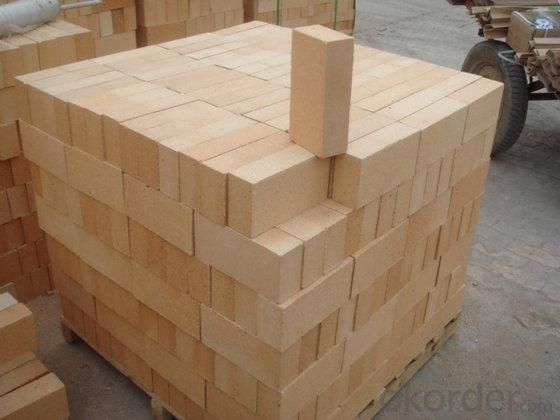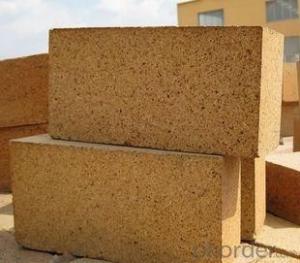High Alumina Fire Brick Light Weight Insulation Refractory Brick
- Loading Port:
- Tianjin
- Payment Terms:
- TT OR LC
- Min Order Qty:
- 20 m.t.
- Supply Capability:
- 10000 m.t./month
OKorder Service Pledge
OKorder Financial Service
You Might Also Like
CNBM conforms strictly to the requirements of ISO 9000 quality control system during the production. MSDS is also available if you want. The thermal insulation fire clay brick meet with the requirements of ASTM & JIS standards. So pls stay cool with our quality.
Brief discription for Alumina Fire Brick
CNBM Alumina Fire Brick are classified according to alumina content ranging from 48% to 90%.
CNBM Alumina Fire Brick are commonly used in blast furnace, hot blast furnace, the roof of electric furnace, teeming ladle, rotary kiln, regenerator, etc.
Brief features for Alumina Fire Brick
◆Low thermal conductivity
◆Excellent acid and base slagging resistance
◆High refractoriness
◆Excellent thermal shock resistance
◆Excellent mechanical strength
◆Good spalling resistance and wear resistance.
◆Good corrosion resistance.
◆High-temperature creep rate is quite low.
◆Good volume stability at high temperature.
◆Low bulk density, low thermal conductivity, good thermal insulation performance.
Technical data for high aluminia bricks
ITEM | UAL48 | UAL55 | UAL65 | UAL75 | UAL80 | UAL85 | ALP80 |
Refractoriness, ℃ | 1750 | 1770 | 1790 | 1790 | 1810 | 1810 | 1810 |
Apparent Porosity,% | 22 | 22 | 23 | 23 | 20 | 20 | 18 |
C.C.S, Mpa | 39 | 44 | 49 | 53 | 55 | 60 | 100 |
Refractories Under Load (0.2Mpa),℃ | 1420 | 1470 | 1500 | 1520 | 1500 | 1520 | 1550 |
Reheating Linear Change,% | 1450℃x2h 0.1~-0.4 | 1500℃x2h 0.1~-0.4 | 1500℃x2h 0.1~-0.4 | 1500℃x2h 0.1~-0.4 | 1550℃x2h -0.5~+0.5 | 1550℃x2h -0.5~+0.5 | 1550℃x2h -0.5~+0.5 |
Al2O3 Content , % | 48 | 55 | 65 | 75 | 80 | 85 | 82 |
Why us
Professional fire brick manufacturer. We have being specialized in producing refractory fireclay brick for more than 40 years so that we can guarantee a stable quality.
Guaranteed quality. Our production process conforms strictly to the requirements of ISO9000 quality management system. Quality inspection is carried out in every links of our production. SGS third party inspection is available.
Sound after sales service. We provide sound after sales service. We provide 24 hours’ consultation service. We are ready to answer your consultations at any time.


- Q:Can insulating fire bricks be used in the construction of glassware production furnaces?
- Insulating fire bricks are capable of being used in the construction of furnaces for glassware production. These fire bricks are specially designed to possess low thermal conductivity, enabling them to tolerate extreme temperatures while effectively providing insulation. This quality makes them highly suitable for deployment in furnaces dedicated to glassware production, as they aid in heat retention and minimize energy wastage. Moreover, these fire bricks exhibit resistance to thermal shock, which is vital in glassware production where sudden temperature fluctuations can arise. In summary, the incorporation of insulating fire bricks in the construction of furnaces for glassware production ensures the equipment operates efficiently and safely.
- Q:Can insulating fire bricks be used in solar power plants?
- Insulating fire bricks have the ability to be utilized in solar power plants. These bricks are specifically designed to possess exceptional thermal insulation properties, thus making them suitable for various applications that demand resistance to heat and energy efficiency. Solar power plants frequently experience high temperatures and the necessity to retain heat, particularly in concentrated solar power (CSP) systems. By using insulating fire bricks to line the walls and floors of CSP receivers and thermal storage systems, the loss of heat can be minimized and the conversion of solar energy into electricity can be maximized. Furthermore, insulating fire bricks can also find utility in other components of solar power plants, such as the insulation of solar panels or the construction of solar tower structures.
- Q:Can insulating fire bricks be used in the construction of ceramic fiber-lined kilns?
- Yes, insulating fire bricks can be used in the construction of ceramic fiber-lined kilns. Insulating fire bricks are designed to provide excellent insulation and can help increase the energy efficiency of the kiln. By using insulating fire bricks, the kiln can reach and maintain higher temperatures while minimizing heat loss through the walls.
- Q:Can insulating fire bricks be used as a heat shield?
- Yes, insulating fire bricks can be used as a heat shield. Insulating fire bricks are designed to have excellent thermal insulation properties, which means that they can effectively block and reflect heat. They are commonly used in applications where heat needs to be contained or redirected, such as in fireplaces, kilns, furnaces, and industrial ovens. The insulating properties of these bricks allow them to reduce heat transfer, providing a barrier between the intense heat source and the surrounding environment. Additionally, they have high melting points and can withstand high temperatures, making them suitable for use as a heat shield. However, it is important to note that the effectiveness of insulating fire bricks as a heat shield may vary depending on the specific requirements and conditions of the application.
- Q:Refractory bricks, burner bricks, insulation bricks? Is it a kind of thing?
- The burner brick is heavy brick, the use temperature is higher, the insulating brick is light brick, the use temperature is lower than the heavy brick.
- Q:Is it necessary to use mortar when installing insulating fire bricks?
- Using mortar during the installation of insulating fire bricks is necessary. It plays a crucial role in bonding the bricks together, guaranteeing a tight and secure fit. Moreover, it contributes to the creation of a sturdy and long-lasting structure capable of enduring high temperatures. Should mortar be absent, the bricks might not be adequately secured and could shift or loosen, thereby compromising the integrity of the installation. Additionally, mortar serves to fill any gaps or spaces between the bricks, providing insulation and preventing heat loss. Consequently, employing mortar is indispensable for a prosperous and efficient installation of insulating fire bricks.
- Q:Can insulating fire bricks be used for insulation in autoclaves?
- Yes, insulating fire bricks can be used for insulation in autoclaves. Insulating fire bricks are designed to have low thermal conductivity, which means they can effectively retain heat and withstand high temperatures. Autoclaves require insulation to maintain a consistent temperature and pressure, and insulating fire bricks can provide excellent insulation properties in these demanding conditions. Additionally, their high strength and durability make them suitable for withstanding the intense heat and pressure cycles that occur in autoclaves. Overall, insulating fire bricks are a reliable and effective choice for insulating autoclaves.
- Q:Outside brick wall, inside brick wall how to return a responsibility?
- In general, the wall of the building and outdoor harsh environment, so the general exterior wall tiles with full ceramic tile surface, then is the kind of uneven, and the appearance of the size deviation of brick is relatively large.
- Q:Can insulating fire bricks be used in ceramic fiber blankets?
- It is not possible to use insulating fire bricks in ceramic fiber blankets. Insulating fire bricks are dense and solid, specifically designed to offer insulation and endure high temperatures in settings like furnaces and kilns. Conversely, ceramic fiber blankets are flexible and lightweight, consisting of ceramic fibers that provide exceptional thermal insulation. They are frequently utilized as insulation in diverse industrial applications, such as lining for furnaces, boilers, and high-temperature equipment. Combining insulating fire bricks with ceramic fiber blankets would not yield effective results because these materials possess distinct properties and serve different purposes.
- Q:Can insulating fire bricks be used for insulation in chemical storage tanks?
- Yes, insulating fire bricks can be used for insulation in chemical storage tanks. Insulating fire bricks are specifically designed to provide high levels of thermal insulation, making them suitable for various industrial applications, including chemical storage tanks. These bricks have excellent insulating properties due to their low thermal conductivity, which helps to minimize heat transfer and maintain a stable temperature inside the tank. Additionally, insulating fire bricks are resistant to high temperatures and can withstand the corrosive nature of many chemicals, making them a suitable choice for insulating chemical storage tanks.
1. Manufacturer Overview |
|
|---|---|
| Location | |
| Year Established | |
| Annual Output Value | |
| Main Markets | |
| Company Certifications | |
2. Manufacturer Certificates |
|
|---|---|
| a) Certification Name | |
| Range | |
| Reference | |
| Validity Period | |
3. Manufacturer Capability |
|
|---|---|
| a)Trade Capacity | |
| Nearest Port | |
| Export Percentage | |
| No.of Employees in Trade Department | |
| Language Spoken: | |
| b)Factory Information | |
| Factory Size: | |
| No. of Production Lines | |
| Contract Manufacturing | |
| Product Price Range | |
Send your message to us
High Alumina Fire Brick Light Weight Insulation Refractory Brick
- Loading Port:
- Tianjin
- Payment Terms:
- TT OR LC
- Min Order Qty:
- 20 m.t.
- Supply Capability:
- 10000 m.t./month
OKorder Service Pledge
OKorder Financial Service
Similar products
New products
Hot products
Related keywords



























